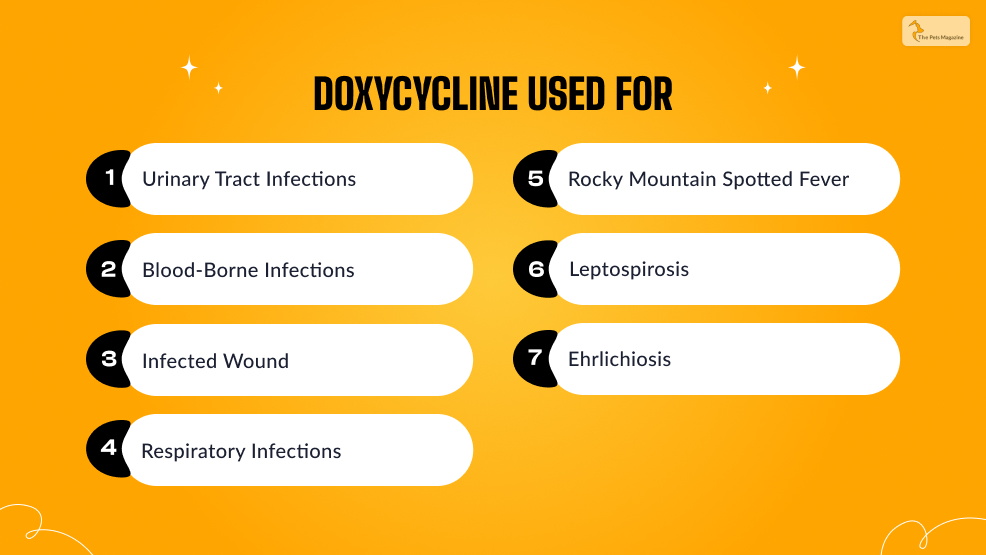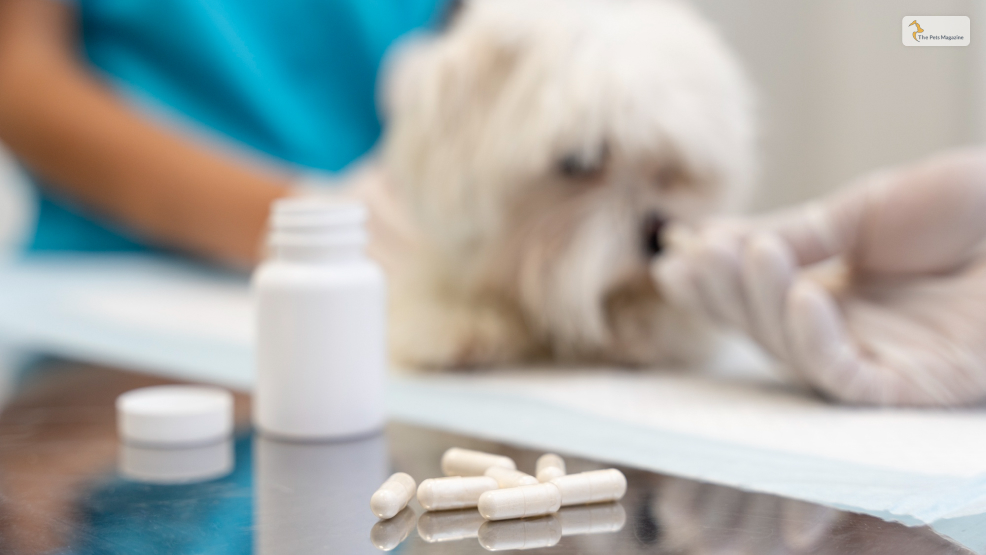Doxycycline Dosage For Dogs: Uses and Side Effects


Dogs are no strangers to antibiotics, be it for an infection they are currently suffering from or to prevent one from happening. One common medication prescribed for dogs is Doxycycline. But before you give it to your pup, it’s important to understand the proper dosage, potential side effects, and safety precautions.
In this article, we’ll dive into everything you need to know about Doxycycline for dogs. We’ll cover its uses, how much to give your dog, and what to watch out for. So let’s get started and ensure your pup gets the best care possible.
What is Doxycycline?
Doxycycline is a broad-spectrum antibiotic that targets a wide pool of bacteria. It also has a wide range of antimicrobial properties that target microbes such as Wolbachia, Dirofilaria immitis, E. coli, Pseudomonas aeruginosa, Serratia, Klebsiella, Truperella, and many others.
Doxycycline falls under the tetracycline family of drugs. These drugs help inhibit protein synthesis, altering the cytoplasmic membrane permeability in cases of vulnerable organisms. It helps fight off bacteria and synthetic sources to create a strong, broad-spectrum antibiotic.
What Is Doxycycline Used For?
Doxycycline is used in dogs to treat potentially dangerous bacterial infections and other infections caused by Canine ehrlichiosis (anaplasmosis), Borrelia burgdorferi (Lyme disease), Rickettsia, Toxoplasma, Leptospirosis, and Neorickettsia helminthoeca (salmon poisoning).

It is not effective against fungal or viral infection. Vets prescribe this medicine to treat an ongoing infection or as a precautionary medication against a secondary bacterial infection. As it happens, viral infections like canine parvovirus leave dogs susceptible to secondary bacterial infections.
Some conditions veterinarians treat using doxycycline are:
- Urinary tract infections
- Blood-borne infections
- Infected wound
- Respiratory infections
- Rocky Mountain Spotted Fever
- Leptospirosis
- Ehrlichiosis
If you dont find your dog’s condition on this list, no worries, as doxycycline has a broad range of uses suitable for a hoard of infections.
What Are the Common Doxycycline Side Effects?

This antibiotic is usually well-tolerated by dogs, but it is always a good idea to consult your vet in order to understand the side effects it could possibly have on them on usage. The most common side effects this antibiotic could have are symptoms of a GI issue, like diarrhea or vomiting. Although severe GI symptoms could mean an overdose of doxycycline, in which case you must get in contact with your vet immediately.
Tetracycline antibiotics could cause skeletal limb deformities in growing puppies in the mother’s womb. It poses a risk for pregnant mother puppers. In some severe cases, the infection far outweighs the pregnancy, in which case, you must let your vet know about the precarity of the situation so that he can make the right call on time.
If your dog has a history of allergic reactions to antibiotics, especially the ones in the tetracycline family, make sure your vet knows so that a potentially fatal allergic reaction can be avoided.
When Should Doxycycline Dosage Be Not Given?
Here are some situations where Doxycycline should not be given to dogs:
- Pregnancy or lactation: Doxycycline can cross the placenta and may be harmful to the fetus or newborn. It can cause skeletal limb abnormalities and teeth discoloration.
- Kidney or liver problems: Doxycycline can accumulate in the body if these organs are not functioning properly.
- Allergy to Doxycycline or tetracyclines: Dogs with allergies to these medications should avoid them.
- Interaction with other medications: Doxycycline can interact with certain other medications, potentially causing adverse effects.
- Young puppies: Doxycycline can affect bone development in young puppies.
Although it is less risky than other drugs of the same composition, it should be otherwise avoided unless the benefits become greater than its risks.
What Is The Correct Doxycycline Dosage For Dogs
The dosage of doxycycline for dogs will vary depending on your dog and his health. Merck Veterinary Manual recommends a dose of 5-10 mg/kg per day, which should not be altered without the prescription of a veterinarian. Changing or altering the dosage could lead your dog to become resistant to the drug.
This means they would take longer to recover or develop a more severe infection than before.
It is best that you consult a vet to know the doxycycline dosage for dogs. They can determine the correct doxycycline dosage for dogs based on several factors. These are as follows:
- Dog’s weight: A larger dog may require a higher dosage.
- Condition being treated: Different infections or diseases may have varying dosage requirements.
- Dog’s overall health: Pre-existing conditions or medications can influence the appropriate dosage.
Always follow your vet’s instructions. They will consider your dog’s individual circumstances and provide the most accurate dosing recommendations.
How To Properly Administer Doxycycline To Dogs

Being highly bioavailable, this medication is absorbed easily into a canine’s body. It can be given with or without food, as long as your dog has access to enough water. The correct way to give your dog doxycycline would be how your vet prescribed it. Your vet will have extensive knowledge of dosage, side effects, drug interactions, and everything else that you won’t.
Here are some common methods:
1. Oral Tablets or Capsules:
Place the tablet or capsule directly into your dog’s mouth. You can also hide it in a treat or piece of food. Some dogs may need a little encouragement to swallow pills.
2. Oral Suspension:
Use a syringe or measuring spoon to administer the correct amount. Squirt the suspension directly into your dog’s mouth. You can also mix it with a small amount of food or water.
3. Chewable Tablets:
Offer the chewable tablet to your dog as a treat. Most dogs enjoy the flavor.
Don’t forget to reward your dog with praise or treats after taking the medication. This can help create a positive association.
Drug Interactions Of Doxycycline
Drug interactions can pose a threat to dogs that are taking a number of drugs at once, similar to humans. Let your vet know if your dog takes any of these medications while doxycycline is being administered:
- Bismuth
- Oral antacids
- Kaolin
- Bactericidal antibiotics such as cephalosporin, aminoglycosides
- Pectin
- Phenobarbital
- Anticoagulant medications such as warfarin
Although it’s not a rule of thumb that your dog can’t take the above-mentioned medications if they are taking doxycycline. But there are possibilities that it could change the way the drug is administered. For example, oral antacids, kaolin, bismuth, and pectin are safe when taken one or two hours before or after taking doxycycline, whereas iron doses must be separated by 3 hours.
Final Thoughts
Doxycycline is used to treat a myriad number of infections in dogs. It is most commonly prescribed by a certified veterinarian and rarely taken as an over-the-counter. It is also considered extra-label in certain cases. Therefore doxycycline dosage for dogs varies too.
Doxycycline is also used as a topical gel to be applied for oral and dental infections. When you ask what is the dosage of doxycycline for dogs, keep in mind that it is a highly potent antibiotic that can be used for several infections as well as a precautionary medication.
But it is best advised not to administer it to your pupper because you think they might need it. Vets will be the best judge in this case, provided you tell him all the necessary details regarding other medicines your dog takes and allergy history. If you have thoughts to share or experience in using this drug for your dog, leave a comment below. We would love to hear from you.
Have you read these?








Leave A Comment